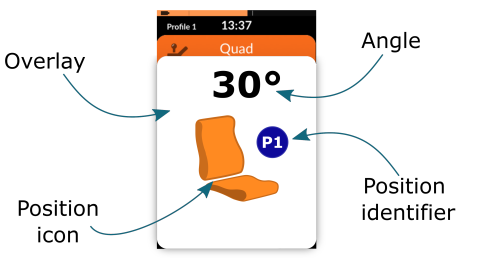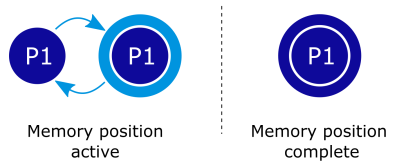How to operate a memory position
This article explains how to operate a memory position from a REM400 or REM500 remote module.
Operating a memory position
Memory positions can be considered as the automated version of motions. With motions, a user controls seating movements manually, selecting both the direction of the motion and when to stop the motion (unless a limit switch is activated). With memory positions, the LiNX system controls the seating movements automatically, selecting both the direction of the actuator movement and when to stop the actuators.
A user can select and activate any pre-defined memory position via a seating function, or by direct access, depending on their chair's configuration. Additionally, any memory position that uses angle feedback can also be updated through a remote module. The following sections show you how memory positions are selected and activated.
Selecting memory positions
To operate a memory position using a display remote module, select the seating function that includes the memory position you want to move to, and then select the memory position with the appropriate joystick action (left / right / forward / reverse). To differentiate between memory positions and motions on a seating card, a position identifier (blue circle, white text) is placed next to the memory position icon.

Figure 1: Selecting and operating a memory position (REM400/500)
For example, Figure 1 shows a seating function with two motions (forward and reverse quadrants) and two memory positions (left and right quadrants). To activate one of the memory positions, deflect the joystick either left or right.
On activation, the selected memory position is shown on the display as an overlay for the duration that the memory position is active. The overlay, as shown in Figure 2, shows the selected memory position icon, the memory position identifier, and the angle of a specific angle sensor, if enabled.

Figure 2: Position overlay (REM400/500)
| NOTE | Only one angle can be displayed for each memory position — the angle displayed is selected when the memory position is configured. |
To indicate that a memory position is active, the position identifier displays a light blue outer circle that fades in and out — Figure 3. When the memory position reaches its target, the outer light blue circle is replaced with a static, dark blue circle.

Figure 3: Memory position active indication
If a memory position is inhibited, a grey strike-out icon is displayed alongside the memory position identifier (Figure 4).

Figure 4: Memory position inhibited
Operating modes
Memory positions activated from seating functions, and using a joystick-based remote module, operate in one of three modes:
- proportional
- switched
- latched
In proportional mode, the selected memory position drives its actuators towards its target for the duration that the joystick is deflected or until the target position is reached. If the joystick is released before the target is reached, the memory position stops driving the actuators. The speed of the memory position is proportional to the joystick's deflection within the memory position's quadrant.
In switched mode, the selected memory position drives its actuators towards its target for the duration that the joystick is deflected or until the target position is reached. If the joystick is released before the target is reached, the memory position stops driving the actuators. The speed of the memory position is selected and fixed through the LiNX Access tools.
In latched mode, the selected memory position drives its corresponding actuators towards its target until the target position is reached. The speed of the memory position is selected and fixed through the LiNX Access tools.
| NOTE |
If you need to deactivate the memory position before it reaches its target:
|
| NOTE |
For more information, see: |